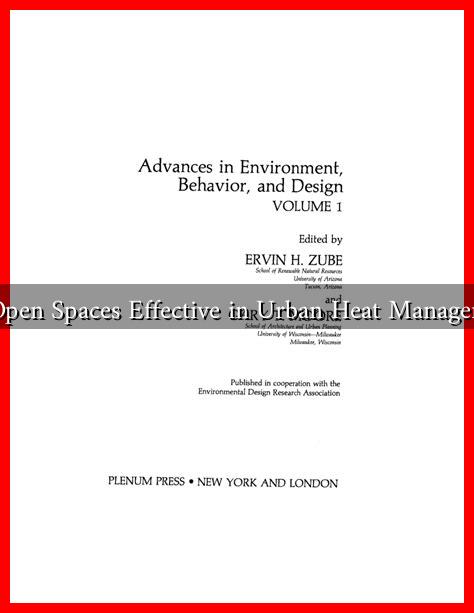-
Table of Contents
Are Open Spaces Effective in Urban Heat Management?
As urbanization continues to rise, cities around the world are grappling with the challenges posed by increasing temperatures. Urban heat islands (UHIs) are a phenomenon where urban areas experience significantly higher temperatures than their rural surroundings, primarily due to human activities and infrastructure. One of the most discussed solutions to mitigate this issue is the incorporation of open spaces in urban planning. But how effective are these open spaces in managing urban heat? This article delves into the role of open spaces in urban heat management, supported by case studies, statistics, and expert opinions.
The Urban Heat Island Effect
The Urban Heat Island effect is characterized by elevated temperatures in urban areas, which can be attributed to several factors:
- Increased concrete and asphalt surfaces that absorb and retain heat.
- Reduced vegetation and tree cover, which normally provide shade and cooling through evapotranspiration.
- Waste heat generated from vehicles, buildings, and industrial activities.
According to the U.S. Environmental Protection Agency (EPA), urban areas can be 2 to 5 degrees Fahrenheit warmer than their rural counterparts, with some cities experiencing temperature differences of up to 10 degrees Fahrenheit. This temperature disparity can lead to increased energy consumption, elevated emissions of air pollutants, and adverse health effects.
The Role of Open Spaces in Mitigating Urban Heat
Open spaces, including parks, green roofs, and community gardens, play a crucial role in urban heat management. Here are some ways they contribute:
- Cooling Effects: Vegetation in open spaces cools the air through shade and evapotranspiration. A study by the National Oceanic and Atmospheric Administration (NOAA) found that urban parks can reduce surrounding temperatures by up to 5 degrees Fahrenheit.
- Improved Air Quality: Green spaces help filter pollutants and improve air quality, which is essential for public health, especially during heatwaves.
- Stormwater Management: Open spaces can absorb rainwater, reducing runoff and the risk of flooding, which is exacerbated by high temperatures.
Case Studies: Success Stories in Urban Heat Management
Several cities have successfully integrated open spaces into their urban planning to combat heat. Here are a few notable examples:
1. New York City, USA
New York City has implemented the “CoolRoofs” initiative, which encourages the installation of reflective roofing materials and the creation of green roofs. The city has also expanded its park system, with the High Line and other green spaces contributing to temperature regulation. A study by the NYC Department of Environmental Protection found that these initiatives have led to a significant reduction in urban heat.
2. Singapore
Singapore is renowned for its extensive greenery, with over 47% of its land area covered in parks and gardens. The city-state has adopted a “City in a Garden” approach, integrating nature into urban design. This strategy has not only helped manage heat but has also enhanced biodiversity and improved residents’ quality of life.
3. Melbourne, Australia
Melbourne’s Urban Forest Strategy aims to increase tree canopy cover to 40% by 2040. The city has invested in creating more parks and green spaces, which has been shown to lower temperatures in densely populated areas. Research indicates that increasing tree cover can reduce surface temperatures by up to 10 degrees Celsius.
Challenges and Considerations
While open spaces are effective in managing urban heat, several challenges must be addressed:
- Maintenance: Open spaces require ongoing maintenance to ensure they remain effective and accessible.
- Equity: Access to green spaces is often unequal, with marginalized communities frequently lacking adequate access to parks and recreational areas.
- Climate Change: As climate change intensifies, the effectiveness of open spaces may be challenged by extreme weather events and changing ecological conditions.
Conclusion
Open spaces are undeniably effective tools in urban heat management, providing cooling effects, improving air quality, and enhancing the overall livability of cities. Successful case studies from cities like New York, Singapore, and Melbourne demonstrate the potential of integrating green spaces into urban planning. However, challenges such as maintenance, equity, and climate change must be addressed to maximize their effectiveness. As urban areas continue to grow, prioritizing open spaces will be essential for creating sustainable and resilient cities. For more information on urban heat management strategies, you can visit the [EPA’s Urban Heat Island website](https://www.epa.gov/heatislands).

